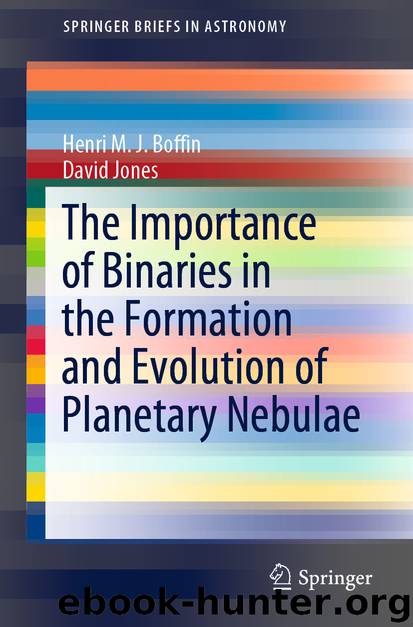The Importance of Binaries in the Formation and Evolution of Planetary Nebulae by Henri M. J. Boffin & David Jones

Author:Henri M. J. Boffin & David Jones
Language: eng
Format: epub
ISBN: 9783030250591
Publisher: Springer International Publishing
We plot in Fig. 4.2 the Roche lobe radius at periastron of two primary stars of different masses in a binary system with a mass ratio1 of 2, as a function of the orbital period, and compare this to the maximum radius reached on the tip of the RGB or the AGB. This provides a very rough idea of the orbital period at which Roche-lobe overflow (RLOF) would take place. Thus, for a 1.5 M primary star, in a binary system, RLOF would happen on the RGB for orbital periods, P, below 500 days () or 1,550 d (), and on the AGB for, resp., P = 1,500 d and P = 4,500 d. For a 3 M, only very short orbital periods would lead to a RLOF on the RGB, while on the AGB this could happen for periods below, resp., 2,800 and 8,000 days. These are only very rough estimates, as physical processes such as tidal circularisation, mass loss and accretion, as well as angular momentum loss will lead to very different values. For example, the BSE code (Hurley et al. 2002), used with the default parameters, shows that for an system with a 3 M primary star, in a binary system, common envelope evolution happens for orbital periods below 3,000 d, stable RLOF happens until 4,000 d, while only wind mass transfer takes place beyond 4,700 d. As we are still far from completely understanding the mass transfer processes involved, these values should only be considered as very indicative. At the very least, they allow us to define some families of stars, which have links with the wide-binaries CSPNe. A useful presentation of these is available in Van Winckel et al. (2010).
As a side note, we could also use the value of 3,000 d shown above to estimate how many post-CE systems we should expect inside PNe, if binarity is not a factor influencing the formation of PNe. Given the period distribution of solar-like stars, we can thus expect to have about 24% of all binaries to lead to a CE. Assuming a 58% binary fraction, this leads to a total fraction of 14% of expected post-CE binary systems among solar-like stars. This is a very conservative number, however, which critically depends on the upper value of the period where a CE could occur. If this value is decreased to 1,000 days, say, the fraction becomes 10%. One can also make the argument that this number is an over-estimate as it includes all systems with orbital periods below the threshold, including systems that may undergo a CE too early to result in a PN (for example, if the orbital separation is particularly small, the CE could occur while on the main sequence) or systems which merge during the CE. As shown by Fig. 4.2, the possible range of orbital periods that would lead to a RLOF on the AGB is rather limited, especially for lower initial masses. Moreover, as shown in Sect. 3.2.2.1, post-CE close binaries seem
Download
This site does not store any files on its server. We only index and link to content provided by other sites. Please contact the content providers to delete copyright contents if any and email us, we'll remove relevant links or contents immediately.
Tools of Titans by Timothy Ferriss(7815)
Turbulence by E. J. Noyes(7702)
Astrophysics for People in a Hurry by Neil DeGrasse Tyson(5002)
Secrets of Antigravity Propulsion: Tesla, UFOs, and Classified Aerospace Technology by Ph.D. Paul A. Laviolette(4994)
Design of Trajectory Optimization Approach for Space Maneuver Vehicle Skip Entry Problems by Runqi Chai & Al Savvaris & Antonios Tsourdos & Senchun Chai(4843)
Room 212 by Kate Stewart(4739)
Pale Blue Dot by Carl Sagan(4618)
The David Icke Guide to the Global Conspiracy (and how to end it) by David Icke(4381)
A Journey Through Divination and Astronomy by Publishing Pottermore(4250)
Apollo 8 by Jeffrey Kluger(3512)
Goodbye Paradise(3446)
Losing the Nobel Prize by Brian Keating(3425)
COSMOS by Carl Sagan(3348)
The Five People You Meet in Heaven by Mitch Albom(3335)
How to Read Water: Clues and Patterns from Puddles to the Sea (Natural Navigation) by Tristan Gooley(3240)
Brief Answers to the Big Questions by Stephen Hawking(3239)
How to Read Nature by Tristan Gooley(3079)
The Order of Time by Carlo Rovelli(3073)
A Brief History of Time by Stephen Hawking(2819)
